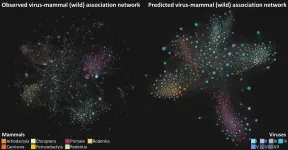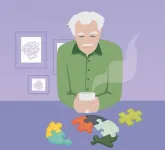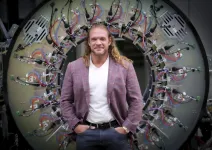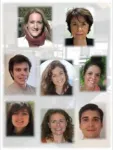(Press-News.org) Researchers at the National Institute of Standards and Technology (NIST) and Wavsens LLC have developed a method for using radio signals to create real-time images and videos of hidden and moving objects, which could help firefighters find escape routes or victims inside buildings filled with fire and smoke. The technique could also help track hypersonic objects such as missiles and space debris.
The new method, described in Nature Communications, could provide critical information to help reduce deaths and injuries. Locating and tracking first responders indoors is a prime goal for the public safety community. Hundreds of thousands of pieces of orbiting space junk are considered dangerous to humans and spacecraft.
"Our system allows real-time imaging around corners and through walls and tracking of fast-moving objects such as millimeter-sized space debris flying at 10 kilometers per second, more than 20,000 miles per hour, all from standoff distances," said physicist Fabio da Silva, who led the development of the system while working at NIST.
"Because we use radio signals, they go through almost everything, like concrete, drywall, wood and glass," da Silva added. "It's pretty cool because not only can we look behind walls, but it takes only a few microseconds of data to make an image frame. The sampling happens at the speed of light, as fast as physically possible."
The NIST imaging method is a variation on radar, which sends an electromagnetic pulse, waits for the reflections, and measures the round-trip time to determine distance to a target. Multisite radar usually has one transmitter and several receivers that receive echoes and triangulate them to locate an object.
"We exploited the multisite radar concept but in our case use lots of transmitters and one receiver," da Silva said. "That way, anything that reflects anywhere in space, we are able to locate and image."
Da Silva explains the imaging process like this:
To image a building, the actual volume of interest is much smaller than the volume of the building itself because it's mostly empty space with sparse stuff in it. To locate a person, you would divide the building into a matrix of cubes. Ordinarily, you would transmit radio signals to each cube individually and analyze the reflections, which is very time consuming. By contrast, the NIST method probes all cubes at the same time and uses the return echo from, say, 10 out of 100 cubes to calculate where the person is. All transmissions will return an image, with the signals forming a pattern and the empty cubes dropping out.
Da Silva has applied for a patent, and he recently left NIST to commercialize the system under the name m-Widar (microwave image detection, analysis and ranging) through a startup company, Wavsens LLC (Westminster, Colorado).
The NIST team demonstrated the technique in an anechoic (non-echoing) chamber, making images of a 3D scene involving a person moving behind drywall. The transmitter power was equivalent to 12 cellphones sending signals simultaneously to create images of the target from a distance of about 10 meters (30 feet) through the wallboard.
Da Silva said the current system has a potential range of up to several kilometers. With some improvements the range could be much farther, limited only by transmitter power and receiver sensitivity, he said.
The basic technique is a form of computational imaging known as transient rendering, which has been around as an image reconstruction tool since 2008. The idea is to use a small sample of signal measurements to reconstruct images based on random patterns and correlations. The technique has previously been used in communications coding and network management, machine learning and some advanced forms of imaging.
Da Silva combined signal processing and modeling techniques from other fields to create a new mathematical formula to reconstruct images. Each transmitter emits different pulse patterns simultaneously, in a specific type of random sequence, which interfere in space and time with the pulses from the other transmitters and produce enough information to build an image.
The transmitting antennas operated at frequencies from 200 megahertz to 10 gigahertz, roughly the upper half of the radio spectrum, which includes microwaves. The receiver consisted of two antennas connected to a signal digitizer. The digitized data were transferred to a laptop computer and uploaded to the graphics processing unit to reconstruct the images.
The NIST team used the method to reconstruct a scene with 1.5 billion samples per second, a corresponding image frame rate of 366 kilohertz (frames per second). By comparison, this is about 100 to 1,000 times more frames per second than a cellphone video camera.
With 12 antennas, the NIST system generated 4096-pixel images, with a resolution of about 10 centimeters across a 10-meter scene. This image resolution can be useful when sensitivity or privacy is a concern. However, the resolution could be improved by upgrading the system using existing technology, including more transmitting antennas and faster random signal generators and digitizers.
In the future, the images could be improved by using quantum entanglement, in which the properties of individual radio signals would become interlinked. Entanglement can improve sensitivity. Radio-frequency quantum illumination schemes could increase reception sensitivity.
The new imaging technique could also be adapted to transmit visible light instead of radio signals -- ultrafast lasers could boost image resolution but would lose the capability to penetrate walls -- or sound waves used for sonar and ultrasound imaging applications.
In addition to imaging of emergency conditions and space debris, the new method might also be used to measure the velocity of shock waves, a key metric for evaluating explosives, and to monitor vital signs such as heart rate and respiration, da Silva said.
INFORMATION:
This work was funded in part by the Public Safety Trust Fund, which provides funding to organizations across NIST leveraging NIST expertise in communications, cybersecurity, manufacturing and sensors for research on critical, lifesaving technologies for first responders.
Paper: F.C.S. da Silva, A.B. Kos, G.E. Antonucci, J.B. Coder, C.W. Nelson and A. Hati. 2020. Continuous Capture Microwave Imaging. Nature Communications. June 25.
A new University of Liverpool study could help scientists mitigate the future spread of zoonotic and livestock diseases caused by existing viruses.
Researchers have used a form or artificial intelligence (AI) called machine-learning to predict more than 20,000 unknown associations between known viruses and susceptible mammalian species. The findings, which are published in Nature Communications, could be used to help target disease surveillance programmes.
Thousands of viruses are known to affect mammals, with recent estimates indicating that less than 1% of mammalian viral diversity has been discovered to date. ...
Canadian researchers at The Ottawa Hospital, the University of Ottawa, the Bruyère Research Institute and ICES have built and validated an online calculator that empowers individuals 55 and over to better understand the health of their brain and how they can reduce their risk of being diagnosed with dementia in the next five years.
Their process was published today in the Journal of Epidemiology and Community Health, and the calculator is available at projectbiglife.ca.
Dementia is an umbrella term for loss of memory and other thinking abilities severe enough to interfere with daily life. Every year, 76,000 new cases of dementia are diagnosed ...
Multisystem Inflammatory Syndrome in Children (MIS-C) significantly affected more Black and Latino children than white children, with Black children at the highest risk, according to a new observational study of 124 pediatric patients treated at Children's National Hospital in Washington, D.C. Researchers also found cardiac complications, including systolic myocardial dysfunction and valvular regurgitation, were more common in MIS-C patients who were critically ill. Of the 124 patients, 63 were ultimately diagnosed with MIS-C and were compared with 61 patients deemed controls who presented with similar symptoms but ultimately had an alternative diagnosis.
In the study, published ...
Burnout is a widespread reality in today's NHS
Current NHS workforce plans are "a smart looking car minus the engine"
An editorial published by The BMJ today raises important concerns about the health
and wellbeing of the NHS workforce after a parliamentary report found "burnout is a widespread reality in today's NHS."
Commenting on the report, Suzie Bailey of the King's Fund says: "Excessive workloads need to be dealt with at every level of the health and care system."
She suggests that ineffective workforce planning is partly to blame, citing evidence ...
New research has discovered that common artificial sweeteners can cause previously healthy gut bacteria to become diseased and invade the gut wall, potentially leading to serious health issues.
The study, published in the International Journal of Molecular Sciences, is the first to show the pathogenic effects of some of the most widely used artificial sweeteners - saccharin, sucralose, and aspartame - on two types of gut bacteria, E. coli (Escherichia coli) and E. faecalis (Enterococcus faecalis).
Previous studies have shown that artificial sweeteners can change the number and type of bacteria in the gut, but this new molecular research, led by academics from Anglia Ruskin University (ARU), has demonstrated that sweeteners can also make ...
A growing trove of data to help scientists understand the biology of Alzheimer's disease among diverse populations within the context of sociocultural, behavioral and environmental factors is now available through the Institute for Translational Research at The University of North Texas Health Science Center at Fort Worth (HSC).
The research data is the result of the Health and Aging Brain among Latino Elders (HABLE) study launched in 2017 with $12 million in funding from the National Institutes of Health and headed by Sid O'Bryant, PhD, Executive Director of the Institute.
In 2020, the HABLE study received an additional $45 million from ...
Over the last decade, severe outbreaks of bacterial canker have caused huge economic losses for kiwi growers, especially in Italy, New Zealand, and China, which are among the largest producers. Bacterial canker is caused by the bacterial pathogen Pseudomonas syringae pv. actinidiae (Psa) and more recent outbreaks have been particularly devastating due to the emergence of a new, extremely aggressive biovar called Psa3.
Due to its recent introduction, the molecular basis of Psa3's virulence is unknown, making it difficult to develop mitigation strategies. In light of this dilemma, a group of scientists at the University of Verona and University of Rome collaborated on ...
In children with rhabdomyosarcoma, or RMS, a rare cancer that affects the muscles and other soft tissues, the presence of mutations in several genes, including TP53, MYOD1, and CDKN2A, appear to be associated with a more aggressive form of the disease and a poorer chance of survival. This finding is from the largest-ever international study on RMS, led by scientists at the National Cancer Institute's (NCI) Center for Cancer Research, part of the National Institutes of Health.
The study, published in the Journal of Clinical Oncology on June 24, provides an unprecedented look at data for a large cohort of patients with RMS, offering genetic clues that could lead to more widespread use of tumor genetic ...
A new study could lead to improved decision making in assigning treatments for children with the aggressive cancer rhabdomyosarcoma after revealing key genetic changes underlying development of the disease.
In the largest and most comprehensive study of rhabdomyosarcoma to date, scientists found that specific genetic changes in tumours are linked to aggressiveness, early age of onset and location in the body.
All these factors affect the chances that children will survive their disease - and understanding how they are driven by a cancer's genetics could lead to new ways of tailoring treatment for each patient.
Rhabdomyosarcoma is a rare type of cancer that resembles muscle tissue and mostly affects ...
Ozone levels in the earth's troposphere (the lowest level of our atmosphere) can now be forecasted with accuracy up to two weeks in advance, a remarkable improvement over current systems that can accurately predict ozone levels only three days ahead. The new artificial intelligence system developed in the University of Houston's Air Quality Forecasting and Modeling Lab could lead to improved ways to control high ozone problems and even contribute to solutions for climate change issues.
"This was very challenging. Nobody had done this previously. I believe we are the first to try to forecast surface ...





